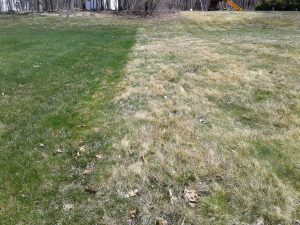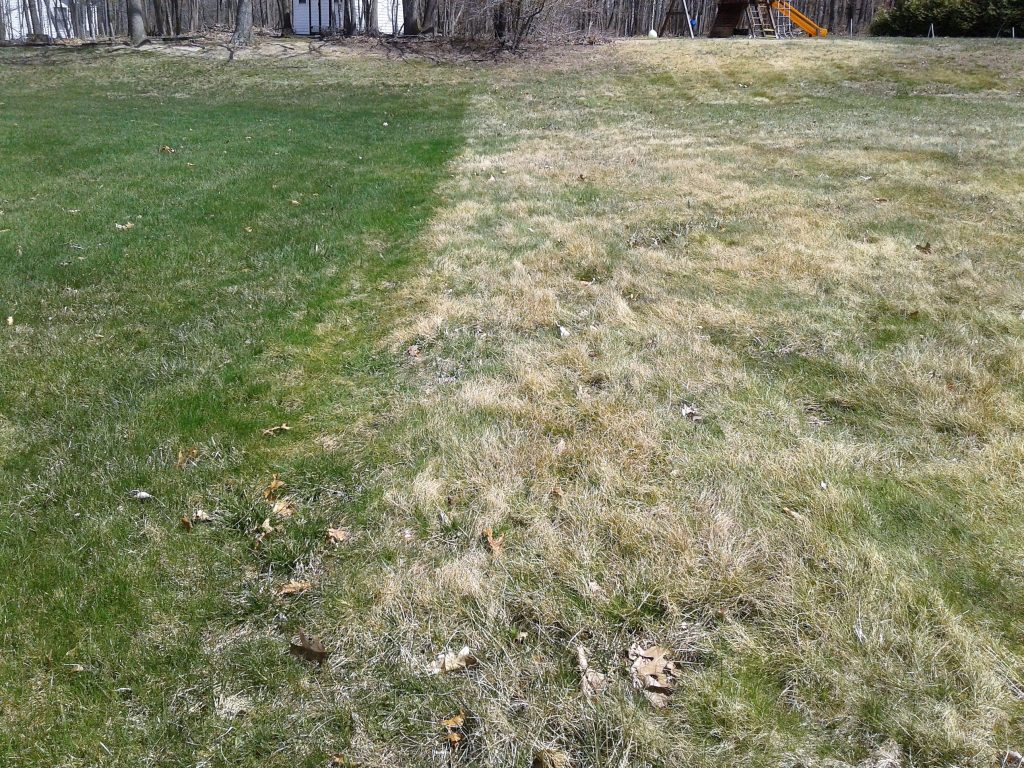When Will My Grass Turn Green Again
When will my lawn green up?


This picture illustrates how a Fine Fescue grass (right) greens up differently than a Blue/Rye grass mix (left).
In the spring, many lawns are brown and still in their winter dormancy state. They will eventually green up, but timing depends on some external factors. Your lawn's green up in the spring is dictated by the temperatures of the soil as well as grass type. The temperature of the soil needs to reach 50 to 65 degrees to actively start the growing and green-up process for northern grasses in our area including rye, blue and fescues. To further complicate things, different species of grasses green up at different soil temperatures. Thicker lawns can take a little longer to green up because the sunlight is not directly getting to the soil, hence taking more time for the soil to reach the desired green-up temperatures. Also, if you have a lot of tree cover or other shade issues, the soil may take a little longer to warm up, delaying your lawn's green up. You can't control the external factors but there are a few things you can do to help your lawn green up a little quicker next spring.
What can be done to help the green up process in the spring?
The most important thing you can do to help your lawn green up in the spring is starting to think about it in the fall. Specifically, a winterizing fertilizer applied late in the fall season will improve the green up process the following spring. The winterizing fertilizer is one of the most important applications for your lawn. It will provide nutrients that help promote root growth and get stored as reserves over the winter. The stored nutrients will be used for new growth and aid with your lawn greening up during the spring.
Once your lawn greens up in the spring you are going to want to keep it that way for the rest of the season. Here are some helpful tips to keep your lawn green all season long especially during the hot and stressful summer months.
- Water the lawn regularly. Your lawn should receive roughly 1 inch of water per week. It is recommended to start running underground sprinklers for 1 to 1 ½ hours per zone, twice a week. As for hose-end sprinklers start at around 4 hours per zone, once a week. If the lawn loses color add more time to your watering schedule not more days. Bump up your watering schedule by half-hour increments weekly until the color is adequate. Watering should occur between midnight and 6 a.m. Watering your lawn at night while you are sleeping will help to minimize the length of time the lawn is wet which will reduce disease activity. It will also help save you money. At night there is no sun to evaporate the water and you will use a lot less water to achieve your watering goals. For hose-end sprinklers, you can go to any home improvement store and purchase battery operated timers and splitters for the hoses to set up in your lawn for overnight watering. Once the hot summer months roll around, the lawn will be under a tremendous amount of stress. If the lawn does not get enough water it will turn brown and go into summer dormancy. Once the lawn turns brown from summer stress it will take heavy watering for to green back up. The secret to having a green lawn all summer long is to water on a regular schedule and keep to that schedule.
- Mow the lawn correctly. The taller grass blades will shade the soil underneath keeping the soil moist longer. Mow the lawn when it needs to be mowed (not because you mow every Wednesday). Mow off 1/3 of the grass blade at a time. Keep the height of cut to 3 – 3 ½ inches in length, and change the direction of the mowing pattern with each mowing. This will help to reduce bending of the grass blade in the same direction and reduce ruts by the tires of the mower. Keep the mower blades sharp to avoid shredding the leaf tips, which can cause infection of disease and the weakening of the grass plants in general.
- Core aerate your lawn annually in the fall. Core aeration is the mechanical process of removing plugs of soil creating small holes in the lawn which allows air, water and nutrients to get down to the grass root zone. This process also helps the grass roots grow deeper and produce a stronger, more vigorously growing lawn. To watch a video and learn more information about core aeration, check out our blog.
- Apply lime. Lime will help to regulate the pH of the soil. When the pH of the soil is low the nutrients in the soil are not completely available for use by the grass plants. If the pH is in the optimum range (between 6.3 – 6.5 for grasses in our area) the lawn can utilize the nutrients to its full capacity which will help create a healthy and stronger lawn. For more information about soil pH and lime, check out our blog.
- Fertilize your lawn regularly throughout the season. By maintaining a good fertilizer program, you are supplying your turf with vital nutrients (like Nitrogen which helps maintain the color of the grass plants) it requires for optimum health, growth and color.
Conclusion
Bottom line, be patient, there is nothing wrong if your lawn greens up later than your neighbor's. It will green up over time, but keeping it green throughout the season, now that's the real trick to a beautiful colorful lawn. If you have any questions about lawn services that can help the lawn green up throughout the year, check out our platinum lawn program.
If you are in our service areas and have questions, please feel free to give our office a call at 908-281-7888.
zimmermanhunce1987.blogspot.com
Source: https://www.fairwaygreeninc.com/when-will-my-lawn-green-up/
0 Response to "When Will My Grass Turn Green Again"
Post a Comment